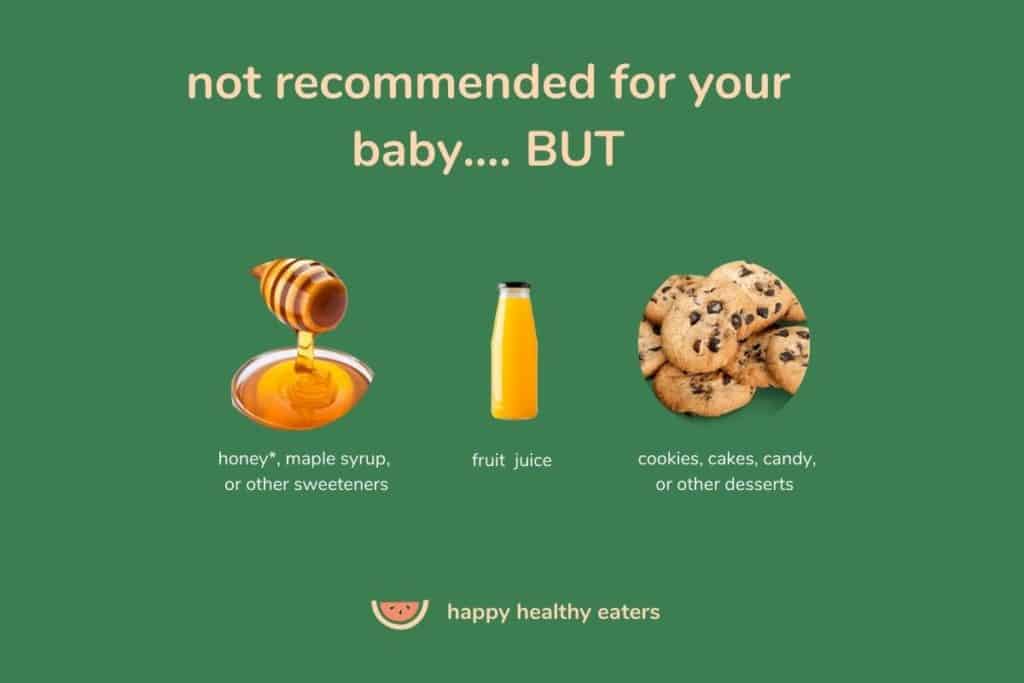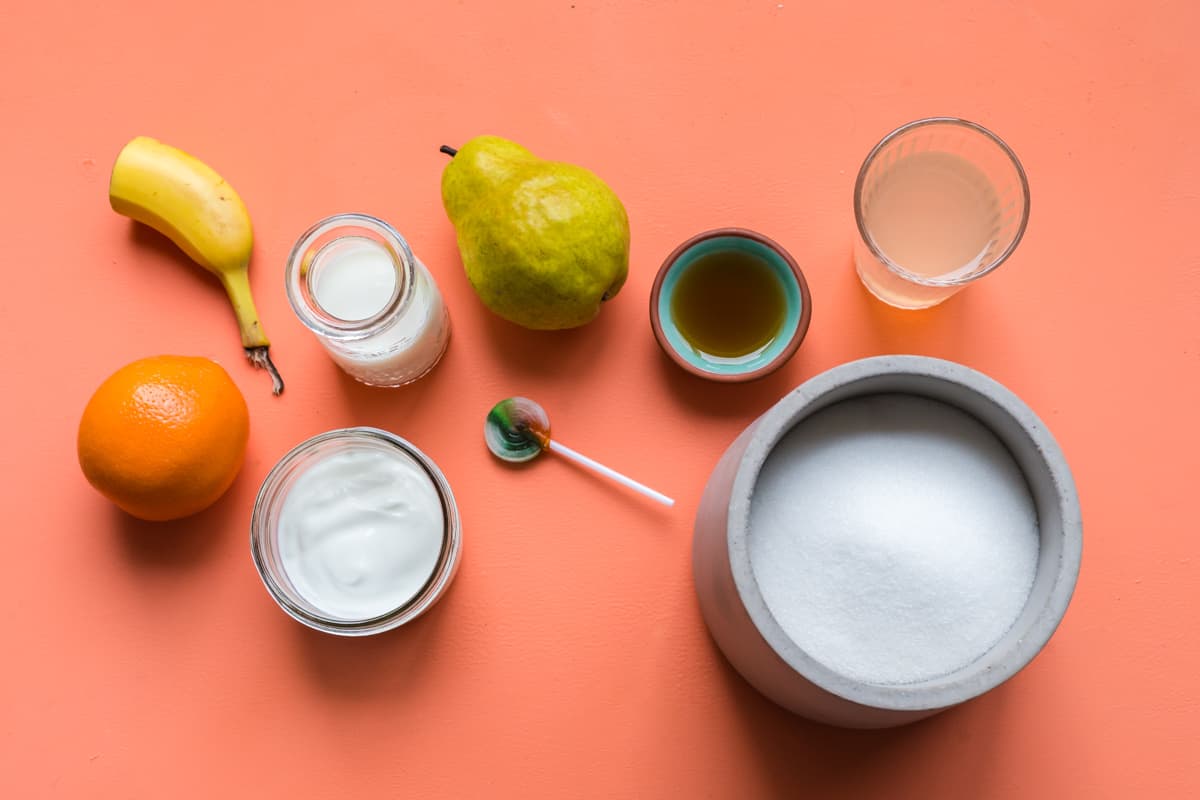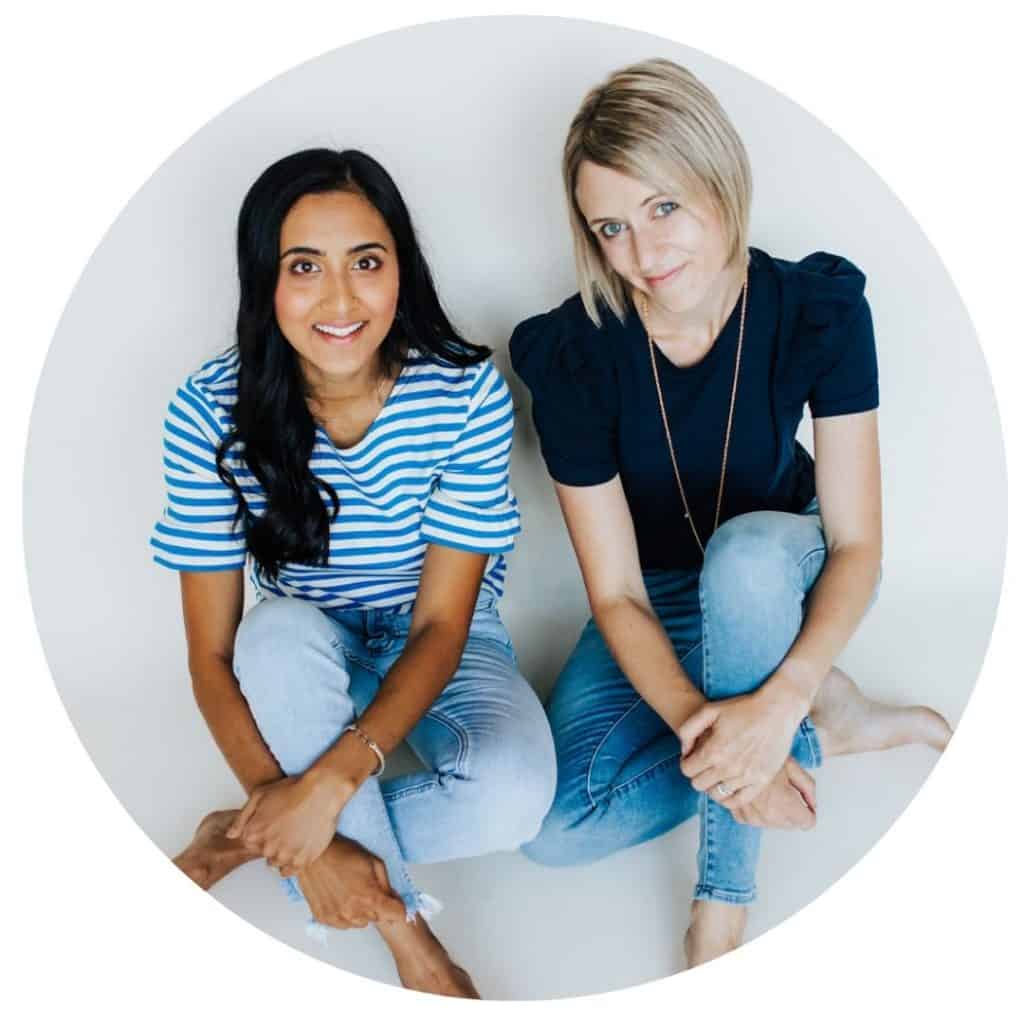No sugar for babies until 2 years old! Sounds like a simple recommendation, doesn’t it? But, as with most things with nutrition, there ends up being a lot of nuance to withholding sugar from our little ones!
Get comfy, because we have a lot to cover in this post!
- why babies (and toddlers) may prefer sweet tasting foods
- how the source of sugar affects the body differently
- what foods contain sugar
- what age to introduce different sweet tasting foods
- how to spot sugar on food labels
- a common sense approach to sugar and toddlers
Why Does My Baby LOVE Sweet Tasting Food?
OK, we’ll let you in on a secret. But actually, maybe you already know? When your baby was in your belly, they had their first taste. It’s true! When babies are in utero, they sip and ingest amniotic fluid. And it just so happens, just like magic, amniotic fluid is sweet tasting.
Ahhh…sweetness, the taste of pleasure… and comfort!
Well guess what? Baby’s first food, colostrum and breastmilk is also sweet tasting.
So in a way, our babies are sort of primed to enjoy sweet tasting food.
They were meant to.
To some degree, there’s a biological purpose for this. When humans consume sweet foods, it stimulates pathways in the brain that send signals that encourage us to feel calm, soothed, and relaxed. It’s no wonder why a baby will suddenly calm at the breast. It’s why you may have heard the sentiment; a mother’s milk is like an analgesic.
What’s this got to do with starting solids? Because it helps you understand why your baby may have unique flavor preferences, and, helps explain why your baby eagerly jumps for joy at the sight of a banana or a juicy strawberry.
To add, we’ve also learned that children (aka not just babies) prefer higher levels of sweet than adults. This is also seen to level out during middle to late adolescence, which is usually when physical growth is not as rapid.
Babies + science = so cool!
Sugar, Sugar, What’s the Difference?
Get your nerd glasses on. It’s science lesson time!
Allow us to share with you a peek into the university courses we nerded out in to learn about chemistry and the human metabolism of SUGAR!
First of all, when sugar from ANY source hits your bloodstream, the body gives zero hoots about where it came from. It has the same chemical structure, regardless of whether it came from a piece of fruit, honey made by the bees, or the refined stuff you find in your sugar bowl.
However, what does matter is:
- How quickly the sugar gets digested and enters your bloodstream and
- How much sugar the body is fed at one given time
And that’s how the source of the sugar CAN matter!
Whole foods like fruit and milk, that naturally contain sugar, also contain other nutrients such as fat and fibre that help slow down the rate at which the body absorbs the sugar. Which means, they don’t spike your blood sugar! Also, these foods are nutritionally balanced; they don’t contain concentrated amounts of sugar. A flood of sugar can be harder for the body to manage.
Bottom line: Don’t be fooled into thinking natural sources of free/added sugars behave any differently in the body than refined sugars. Whole foods that contain sugar have not been shown to be detrimental to health outcomes.

When Can My Baby Have?…..
We’re going to make this short and sweet (pun intended, lol). The basic recommendations for little ones 2 and under is to avoid offering any foods with added or free sugars.
This means no:
- juice
- honey, maple syrup, and other sweeteners
- cookies, cakes, ice cream, candy, and other desserts
Is sugar dangerous for babies? No. There are no direct safety concerns with sugar.
Is sugar a common allergen in babies and children? No.
So what’s the deal with avoiding sugar for babies and toddlers?
Sugar can take the place of other important foods and nutrients that babies and young toddlers need to grow and develop. When researchers evaluate childhood needs, there just isn’t a lot of wiggle room given their energy and nutrient requirements.
However, you know us, and we KEEP IT REAL. At some point, your toddler is going to realize that she doesn’t always get offered certain foods that other people get to eat….especially if there are older siblings around or perhaps other kids in a childcare setting.
Keeping these real life situations in mind and the fact that one of the goals of raising a Happy Healthy Eater is to raise a child who doesn’t feel restricted around food, we propose slightly different recommendations.
Avoid offering your child foods with added/free sugars until the bare minimum of 12 months old. At this point, keep avoiding sweetened foods until they start to clue in that they’re not getting something the rest of the family is. At this point, you can offer a small, appropriately sized portion when everyone else is enjoying something sweet.
Does that sound reasonable? We sure think so!
Perspective: when we had our first boys, not offering sugary foods until after age 2 was pretty easy. The same was not so true with our second boys. Both Hendrix and Luksh were exposed to home baked muffins, a roasted marshmallow and the odd cake at birthday parties earlier. As far as we’re concerned, we have bigger fish to fry like teaching our children about respect, consent and kindness vs being a total food police. We hope this doesn’t send the message that we “don’t care”, because we do. It’s just about being honest with expectations!
You may also be interested in: best fish for babies [+should I be worried about mercury?]

As a summary, here are the recommendations:
When Can My Baby Have Fruit?
As soon as your baby starts solids foods, they can have fruit! There’s no need to shy away from whole food sources that naturally contain sugar.
Additionally, there’s no scientific evidence that veggies need to be introduced before fruit. Veggies taste bitter and it may take a while for babies to learn to like them, regardless of what other foods they’ve been exposed to.
Remember: amniotic fluid and breastmilk are sweet so your baby already knows what “sweet” tastes like!
When Can My Baby Have Honey?
For honey, there’s a legit safety issue for babies under 12 months of age. It’s rare but honey could contain spores of a bacteria called clostridium botulinum. Developed guts have the ability to render these spores inert, which is why honey is not a problem for those over one year of age. But for infants, this food borne illness could be fatal. Oh, and the spores aren’t killed by heat so both raw and pasteurized honey are no-nos.
When Can My Baby Have Cookies, Cakes, Donuts and other Sugar Sweetened Foods?
Optimally, try to hold off on these foods until two years old. However, if you notice your baby is feeling deprived because she’s not getting to partake in foods those around her are eating, you don’t want her to feel restricted, which only increases the enticement of these foods! So, at your discretion, you may offer toddler sized portions after 12 months of age. See the section above for more detail on our balanced real-life approach!
When Can My Baby Have Maple Syrup and other Natural Sweeteners?
The human body doesn’t differentiate between natural sweeteners and refined sugars such as table sugar. As such, natural should be treated the same way as cookies, cakes, donuts, etc.
When Can My Baby Have Juice?
Babies, toddlers, children, and basically humans of all ages don’t need juice! However, if this is a food you enjoy in your household, it’s best to hold off until two year of age, if that’s realistic. And then it should be limited to 1/2 cup a day.
How to Spot Sugar on Food Labels
If you live in the USA, you’re in luck! Food labels now have a line for ADDED SUGARS. This line will include all sugars that aren’t naturally found in dairy, fruits or vegetables (except concentrated fruit or vegetable juices).
If you live in Canada, you’ll need to check the ingredient list. There are a ton of different ingredients that are forms of added sugars. Almost anything ending in “ose” will be a form of sugar. Other common words to look out for are syrup, concentrated fruit juice, caramel, and agave nectar.
I’ve got a toddler. How do I approach sweets?
First things first: as always, we strive to be a judgement free space. We know that the topic of sugar brings up lots of feelings for different people, so let’s read this with an open mind.
If you’ve got a toddler who is about 24+ months, you may want to intentionally start serving sweets, treats, and desserts – both homemade or ready made. Why?
- Because we want your child to GROW UP to have a positive relationship with sweet foods.
- We want your child to be able to self regulate around sweet foods.
- Both 1 and 2 help to raise an intuitive and competent eater. And, decrease the likelihood of disordered type eating behaviors later in life.
- We want to protect our children from the $70 billion dollar diet industry #FUdietculture
Trusssssssst us – as Registered Dietitians it took us a little bit of extra literature reviewing to feel so secure with these recommendations. It’s well documented: restricting foods from the home environment increases children’s preferences for those foods, makes them more
likely to overeat them when they do have access, and increases their risk of binging.
No thank you.
HOW you offer treats in your home will differ from family to family. In our homes sweet/sugary foods are served 1 – 2x almost daily.
The both of us here at Happy Healthy Eaters:
- allow our children an opportunity to enjoy one serving of dessert WITH meals
- instead of calling them “treats” or “sometimes foods” or “fun foods” we do our best to call the sweet food what it is: “we’re having ice cream” “here are some gummy bears with your cheese and crackers” or “we’re having roasted marshmallows”.
- keep the tone very neutral – we do not glamorize the sweet food, it gets the same type of attention as the broccoli, roti or pasta
- from time to time we allow our children an opportunity to have as much or as little of the sweet food – this allows them an opportunity to self regulate
- when able, we remove the packaging on ready made foods like granola bars, cookies and fruit snacks
We’ve really only scraped the surface of things here….but we’re curious. What does this bring up for you? How do you feel about sweets and your child maybe one day enjoying them? What was your relationship like with food?
We’ll leave you with this…when we start to consider our own relationship with our body and food we do the hard work of liberating our children from what we live through #dietculture.
Be gentle with yourself.
XO Jess and Nita







2 thoughts on “Babies, Sweets, and Sugar: the complete 411!”
LOVE the work you’re doing to help liberate next generation from the diet culture. I do agree with all said above and will try to follow it when introducing solids to my baby. Thank you for the great info and great courses.
And thank YOU for your support!